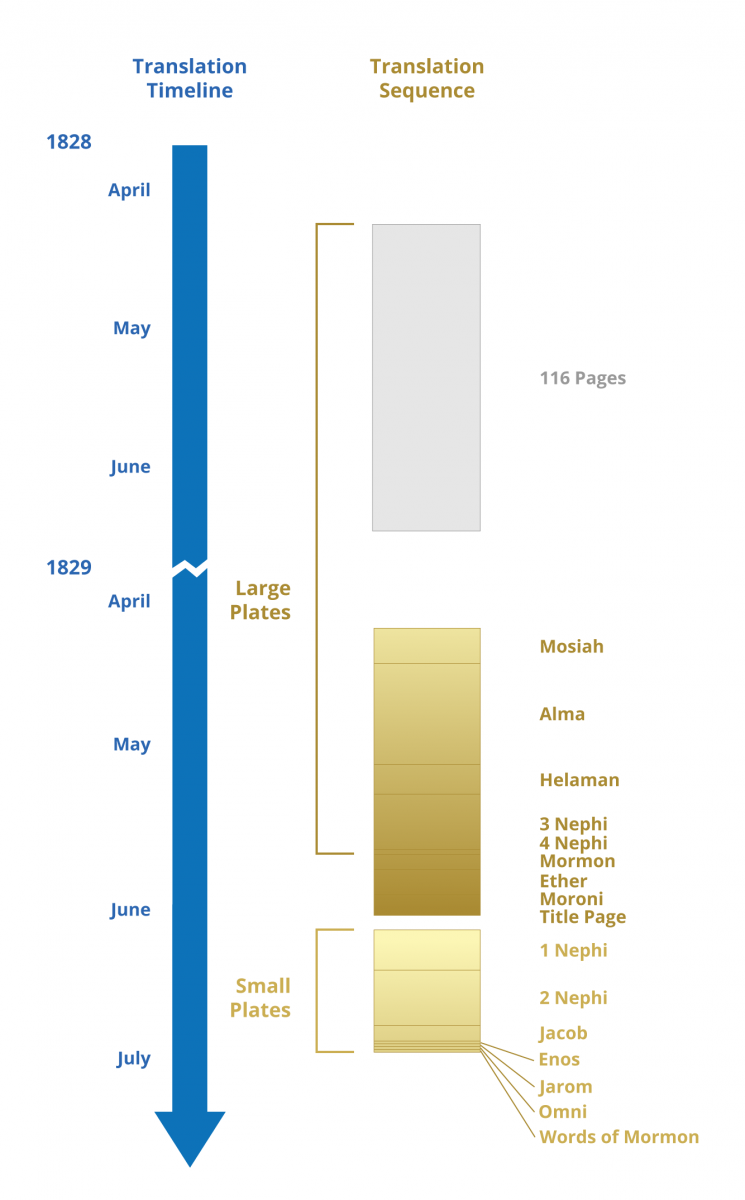Evidence #86 | September 19, 2020
Book of Mormon Evidence: Mosiah-First Translation
Post contributed by
Scripture Central

Abstract
When viewed in light of the Mosiah-First translation sequence, a number of textual allusions to the Small Plates of Nephi are difficult to explain for theories that assume Joseph Smith was the creator, rather than the divinely aided translator, of the Book of Mormon.Scholars now widely agree that the books in the Book of Mormon were translated in the order shown in the following graph (Mosiah–Words of Mormon), rather than in the order that they were eventually published (1 Nephi–Moroni).1

Besides making clear sense of the manuscript and historical data, this understanding of the translation sequence (sometimes called the Mosiah-First theory) also provides evidence for the Book of Mormon’s complexity. This is because many passages from Mormon’s abridgment of the Large Plates, as well as from the books of Mormon, Ether and Moroni, refer back to content from the Small Plates (see Appendix), even though the Small Plates hadn’t even been translated yet.
For instance, in Alma 3 Mormon referred to prophecies about a curse upon the Lamanites and those who would mix with their seed. This prophecy can be found in 2 Nephi 5:
2 Nephi 5 | Alma 3 |
21 And he had caused the cursing to come upon them, yea, even a sore cursing … 23 And cursed shall be the seed of him that mixeth with their seed; for they shall be cursed even with the same cursing. And the Lord spake it, and it was done. | 14 Thus the word of God is fulfilled, for these are the words which he said to Nephi: Behold, the Lamanites have I cursed … 15 And again: I will set a mark upon him that mingleth his seed with thy brethren, that they may be cursed also. |
In Alma 36:22, Alma referred to a vision given to the prophet Lehi. Alma’s specific phrasing is a verbatim quote from 1 Nephi 1:8:
1 Nephi 1:8 | Alma 36:22 |
And being thus overcome with the Spirit, he was carried away in a vision, even that he saw the heavens open, and he thought he saw God sitting upon his throne, surrounded with numberless concourses of angels in the attitude of singing and praising their God. | Yea, methought I saw, even as our father Lehi saw, God sitting upon his throne, surrounded with numberless concourses of angels, in the attitude of singing and praising their God; yea, and my soul did long to be there. |
And, in a final sample, language from Alma’s famous sermon on faith in Alma 32, and also from a description of Jesus and his followers in 3 Nephi 19, clearly allude to the Tree of Life imagery found in 1 Nephi 8 and 1 Nephi 15:
1 Nephi 8:11 | 1 Nephi 11:8 | Alma 32:42 | 3 Nephi 19:25 |
And it came to pass that I did go forth and partake of the fruit thereof; and I beheld that it was most sweet, above all that I ever before tasted. Yea, and I beheld that the fruit thereof was white, to exceed all the whiteness that I had ever seen. | And I looked and beheld a tree; and it was like unto the tree which my father had seen; and the beauty thereof was far beyond, yea, exceeding of all beauty; and the whiteness thereof did exceed the whiteness of the driven snow. | … behold, by and by ye shall pluck the fruit thereof, which is most precious, which is sweet above all that is sweet, and which is white above all that is white, yea, and pure above all that is pure; | … and behold they were as white as the countenance and also the garments of Jesus; and behold the whiteness thereof did exceed all the whiteness, yea, even there could be nothing upon earth so white as the whiteness thereof. |
These relatively frequent allusions and references back to content from the Small Plates make sense if the Book of Mormon is truly a compilation of ancient prophetic writings, as the text itself claims. Mormon, Alma, and other later prophets would have had Lehi’s and Nephi’s earlier writings to refer to and quote from, whether from the Small Plates themselves or from related texts (or versions of the same texts) on the Large Plates. On the other hand, these sometimes complex textual allusions are difficult to explain if Joseph Smith was simply making up the Book of Mormon’s content, as some have supposed. This is because, according to the witnesses of the translation, he rapidly dictated the Book of Mormon without relying on any outlines, notes, or reference materials.2
Commenting upon the allusions to the visions of the Tree of Life recorded in the Small Plates, literary scholar Alan Goff has argued, “It seems overly complicated to posit that a whole web of allusions to these tree of life images is created first and then later the coherent story that ties them all together.” Likewise, in regard to Mormon’s reference to 2 Nephi 5:21–24, as found in Alma 3:14, Goff explained,
If the Alma passage were written prior to the 2 Nephi passage, then Joseph Smith not only would have had to remember to pen the Nephi text without being able to refer back to the other passage but would also have had to build the specific reference to Nephi as the original source long before Nephi became the original source.
Further analysis suggests the task may have been even more difficult than Goff has proposed. Not only does Mormon’s abridgment repeatedly refer or allude to content in the Small Plates, but it seems that some of its major narratives were specifically designed to show the fulfillment of Nephi’s earlier prophecies. In other words, not only minor textual elements, but the core design and undergirding structure of Mormon’s abridgment may be based on passages that, if Joseph were just making things up, hadn’t yet been written.
Book of Mormon Central, “How Does the ‘Mosiah-First’ Translation Sequence Strengthen Faith? (Words of Mormon 1:5),” KnoWhy 503 (February 22, 2019).
Alan Goff, “Positivism and the Priority of Ideology in Mosiah-First Theories of Book of Mormon Production,” FARMS Review 16, no. 1 (2004): 11–36.
Intertextual Connections to the Small Plates *Intertextual relationships that are more easily explained by the text’s own claims about its origins, in light of the Mosiah-First translation sequence, are indicated by an asterisk.3 | ||
Topic | Quotation/Allusion | Small Plates |
*Nephi and Lehi’s Goodness4 | ||
*Similar Introductions5 | ||
Making a Record in the Egyptian Language according to the Writer’s Knowledge |
| |
*Making a Record With Hands and Knowing the Record’s Truth |
|
|
*God Sitting on His Throne | ||
Choirs Singing and Praising God | ||
Christ Will Descend Out of Heaven | ||
*Firm, Steadfast, and Immovable | ||
*Lehi’s Posterity Will Prosper or Be Cursed |
| |
*The Brass Plates Will Be Preserved |
| |
*Desirable Fruit |
| |
*Sweet/White Fruit | ||
*Iron Rod/Word of God | ||
*Grafted into the True Vine |
| |
Days of Probation |
| |
Partake of Fruit/Waters of Life |
| |
Living Waters/Love of God |
| |
Tumultuous Noises Will Be Heard | ||
Rocks and Earth Will Be Rent | ||
Cities Will Be Sunken | ||
Cities Will Be Burned | ||
Cities Will Be Shaken and Tumble | ||
A Vapor of Darkness Will Be Removed | ||
The Righteous Will Be Preserved from Destruction | ||
Heavens Will Open | ||
The Lamb of God Will Descend | ||
The Holy Ghost Will Fall on Twelve Disciples | ||
Twelve Disciples Will Be Chosen and Ordained | ||
Twelve Disciples Will Judge the Nephites |
| |
Righteous Generations Will Precede Final Destruction | ||
Lamanites will Overcome Nephites | ||
Nephite/Lamanite Mixture Won’t Be Utterly Destroyed | ||
Nephites Will Record Christ’s Words | ||
Justice/Hell Imagery | ||
Those Who Are Filthy Can’t Enter God’s Kingdom | ||
The Lord Will Visit the Righteous with His Voice | ||
The Earth Will Groan | ||
*Travelers to the Promised Land Must Be Led by the Lord | ||
*God Will Mark Lamanites to Make Them Unenticing | ||
*Nephites Who Mix with Lamanites Will Be Cursed | ||
*Living after the Manner of Happiness | ||
Signs Will Be Given of Christ’s Birth | ||
Signs Will Be Given of Christ’s Death | ||
The Wicked Will Perish for Stoning, Slaying, and Casting out Prophets | ||
Blood of the Saints Will Cry from the Ground | ||
Depths of the Earth Will Swallow the Wicked | ||
Mountains Will Cover the Wicked | ||
Whirlwinds Will Carry Away the Wicked | ||
Buildings Will Fall and Crush the Wicked |
| |
Despite Persecution, Righteous Saints Will Steadfastly Look for the Signs of Christ’s Coming | ||
Christ Will Heal the People | ||
Christ’s Ministry Will Be Followed by Generations of Peace | ||
The Spirit Will Cease to Strive with the Nephites | ||
Nephites Will Be Speedily Destroyed | ||
- 1. See John W. Welch, “Timing the Translation of the Book of Mormon: ‘Days [and Hours] Never to Be Forgotten’,” BYU Studies Quarterly 57, no. 4 (2018): 22–23; John W. Welch, “The Miraculous Timing of the Translation of the Book of Mormon,” in Opening the Heavens: Accounts of Divine Manifestations, 1820–1844, ed. John W. Welch, 1st edition (Salt Lake City and Provo, UT: Deseret Book and BYU Press, 2005), 115–117.
- 2. See John W. Welch, “The Miraculous Timing of the Translation of the Book of Mormon,” in Opening the Heavens: Accounts of Divine Manifestations, 1820–1844, 2nd edition, ed. John W. Welch (Salt Lake City and Provo, UT: Deseret Book and BYU Press, 2017), 143, 168; Daniel C. Peterson, “Editor's Introduction—Not So Easily Dismissed: Some Facts for Which Counterexplanations of the Book of Mormon Will Need to Account,” FARMS Review 17, no. 2 (2005): xiii–xvi; Royal Skousen, “How Joseph Smith Translated the Book of Mormon: Evidence from the Original Manuscript,” Journal of Book of Mormon Studies 7, no. 1 (1998): 24.
- 3. Not all of these intertextual connections place an additional burden on naturalistic theories about the text’s origin and authorship. For instance, in a situation where the beginning of a story was written after its ending, a creative author could plausibly recast events that have already taken place in a narrative as prophecies about what will take place in the future, such as Nephi’s prophecies about Christ arriving in the Americas and the great destruction that preceded His arrival. Only those textual connections that seem clearly better explained by later authors subtly modeling or closely referencing something they were familiar with in earlier Nephite history or texts (rather than Joseph Smith supplying the origin of these connections after the fact in a fictional story) are indicated by an asterisk. At the very least, the rest of the intertextual relationships demonstrate the sophisticated and, in many cases, the nuanced or subtle relationships between the content in the Small and Large Plates.
- 4. Matthew L. Bowen, “‘He Is a Good Man’: The Fulfillment of Helaman 5:6–7 in Helaman 8:7 and 11:18–19,” Interpreter: A Journal of Latter-day Saint Faith and Scholarship 17 (2016): 167–168.
- 5. See Matthew L. Bowen, “Nephi’s Good Inclusio,” Interpreter: A Journal of Latter-day Saint Faith and Scholarship 17 (2016): 181–195.